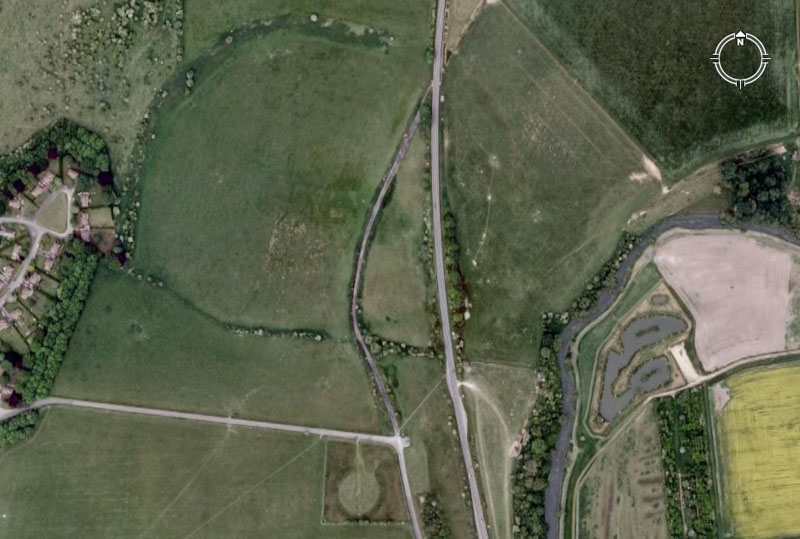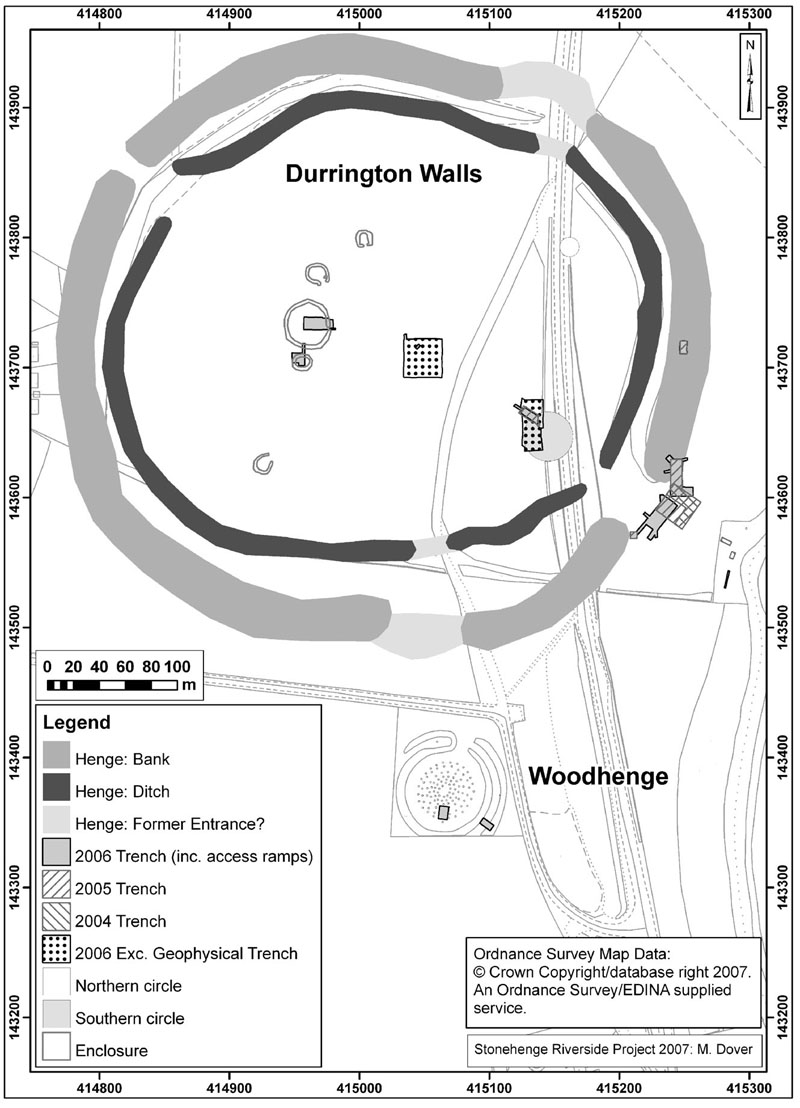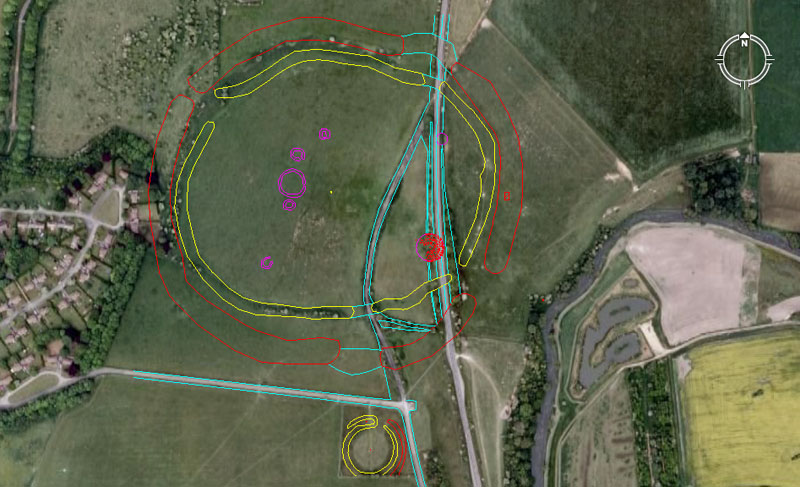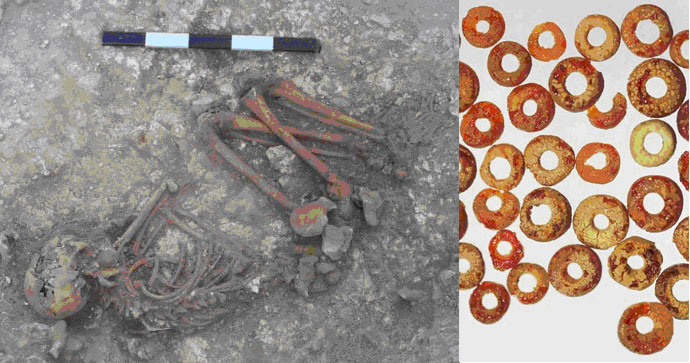DURRINGTON WALLS HENGE
The second largest henge structure known to exist in Britain
or Continental Europe is Durrington Walls Henge in Wiltshire, Southern England,
second only to Marden Henge further NNW.
Essentially, Durrington Walls Henge is simply the major component
in a landscape series of interrelated sites, including nearby Stonehenge,
the recently discovered sites dubbed Bluestonehenge & Woodstonehenge,
Woodhenge, Coneybury Henge, as well as other, smaller henge-type structures.
Acting as outer markers or distance and angle targets away from these hub
centres are the mound complexes, like the sets or groups at Durrington Downs,
The Packway, The Lesser Cursus and Cursus, Winterbourne Stoke, Normanton Downs,
North Kite and the Lake Barrows, Wilsford, Lake Down, Vespasian's Camp, Larkhill
and the King Barrows, etc. These several hundred purpose-built, outlying marker
positions are situated from less than half a mile, up to 5 miles out from
the main henge sites of the district. In this study we will show the coded
mathematical relationships existing between these many outer structures and
the centre position of Durrington Walls Henge, which acted as the main hub
position for all secondary structures in the district.

The vague outline of Durrington Henge's ditch and outer
embankments can be seen in the top section of this picture, with the restored
small henge called Woodhenge situated South of its massive counterpart. Many
centuries of ploughing have seriously lowered the embankments of Durrington
Walls Henge and all but eradicated them in places. Yet another major road
was cut through the henge in 1967-68 and a former large diameter wooden-post
circle was discovered during the road excavations. Sadly, the vast majority
of those post circle positions now sit under the new highway.
But it was not all bad news. The incentive to cut a major arterial
route through the giant henge at least forced the archaeological community
to do a major investigation, coupled with a vast dig, within Durrington Walls
Henge. All of the Neolithic Age post holes of the henge's southern circle,
shortly before they disappeared under the roading tarmac, were carefully measured
and their exact positions logged for future reference. The site itself was
carefully surveyed and precise plans were drawn for the worldwide research
community. As the new road stretched further into the henge, yet another,
albeit smaller, post circle was found further North. It also was painstakenly
assessed by archaeologists, with the positons shortly to disappear under the
tarmac carefully photographed, measured, plotted and recorded.

Plan of Durrington Walls, showing positions of trenches
excavated in 2004 and 2005 (drawn by Mark Dover from Wainwright with Longworth
1971).
The extensive work undertaken in the late sixties lent impetus
to ongoing, periodic digs, which continue to this day. During a period spanning
over 40-years many former positions of important structures within the henge
have been newly identified and it's now possible to form a picture of the
design intent and function of Durrington Walls Henge, as well as its southern
appendage site, Woodhenge.

Using Mark Dover's precise plan, which was based upon
earlier accrued measurements from Wainwright with Longworth (1971), as well
as modern electronic measurement and mapping technologies, a very accurate
overlay of the Google Earth landscape can now be done. The circumnavigating
ditch of the henge, alone, would have been 16 metres (52.5-feet) wide and
6 metres (20-feet) deep, with an outer ring perimeter wall of compacted, heaped-up
chalk 3 metres (10-feet) high that was almost a mile in circumference.
It has long-since been the impression of the research community
that Durrington Walls Henge was so utterly dilapidated and obscured by "tillage",
as to be mostly beyond a point where it could tell us very much about the
intent of its builders. Whereas places like Avebury Henge, 16.5-miles to the
NNW retained many original marker obelisks or the holes where obelisks once
stood, Durrington's marker components seemed to be irrevocably erased, sufficient
to render the site undecipherable in a surveying sense. However, archaeological
work of the past four decades has clearly identified many former post structures
within and outside the henge and the huge site can still provide us with considerable
design layout information, especially concerning the henge's relationship
to outlying mounds or lesser henge sites nearby.
Note the following features within the henge itself:
SO, WHY DID ANCIENT PEOPLE BUILD HENGES?
They were built as the primary fulcrum structures within sprawling
"open air universities". At these ancient schools the "brightest
and the best" of gifted children were taught the astronomical and navigational
arts. The concept of a horizontal-top henge wall was for creating an artificial
horizon, similar to what one would see from a ship on the vast featureless
oceans. Students situated within the henge, primarily at its centre, could
become very familiar with the star, planet, sun and moon rise and set positions
or cycles, by using the top of the henge embankments as the target region
for 360-degree observation onto the ever moving and changing stellar display.
This is consistent with what Julius Caesar said concerning the great schools
of Britain run by the Druids of his time.
'They do not think it proper to
commit these utterances to writing, although in all other matters and in their
public and private accounts they make use of Greek characters. I believe that
they have adopted the practice for two reasons- that they do not wish the
rule to become common property, nor those who learn the rule to rely on writing
and so neglect the cultivation of memory; and, in fact, it does usually happen
that the assistance of writing tends to relax the diligence of the student
and the action of memory...They also lecture on the
stars in their motion, the magnitude of the Earth
and its divisions, on natural history, on the power and government
of God; and instruct the youth in these subjects' (see
De Ballo Gallico, VII, 15, 16.).
The late era Druidic schools that Julius Caesar commented about,
undoubtedly, had a pedigree back to similar schools maintained during the
Neolithic and Bronze Ages*.
British historian, Isabel Hill Elder, commenting on the Druidic schools, writes:
'The students at these colleges
numbered at times sixty thousand of the youth and young nobility of Britain
and Gaul. Caesar comments on the fact that the Gauls sent their youth to Britain
to be educated...It required twenty years to master the complete circle of
Druidic knowledge. Natural philosophy, astronomy, mathematics,
geometry, medicine, jurisprudence, poetry and oratory were all proposed
and taught-natural philosophy and astronomy with severe
exactitude' (Elder refers to Strabo I IV,
page 197. Caesars Comm. Lib V. Sueotonius, V Calegula. E. Campion, Accounts
of Ireland, pg. 18.).
In Caesar's mention of astronomy, mathematics & geometry
it will be shown that there was a particular parcel of numbers (the numbers
of civilisation) that had to be remembered at all cost and handed down intact
to each ensuing generation. This is why such a mammoth effort was put into
constructing Durrington Walls Henge and its many appendage structures ...
to encode into marked positions and then teach the hard won sciences of navigation
at sea (positional plotting using sophisticated mathematical methods), astronomy
(cycles, constellation patterns and the bright navigational star positions),
the calendar (tracking the daily positions of both the Sun and the Moon against
the backdrop of stars) or all of the factorable number systems that described
these ancient sciences.
*Footnote: Several
graves have been found in the vicinity of Stonehenge, the occupants of which
had come from far off countries before dying and receiving dignified interrments
close to the Stonehenge monument. The most recent find of this type is "The
Boy With The Amber Necklance", who was only
about 14-15 years old when he died in Wiltshire, but who had grown up in the
Mediterranean circa 1550 BC.
Knowing as we do now that this area around Durrington Walls Henge was a sprawling,
open air university, it seems likely that the young man was an apprentice
of the navigational and astronomical crafts, sent from his homeland to receive
an education in Southern England. In this quest he was, undoubtedly, like
the Amesbury Archer from Germany who preceeded him by 1000-years, or the youths
from Gaul who attended the great school 1500-years after the boy had died.

'The boy's skeleton was discovered in 2002 at Stonehenge
... By analysing the ratio of two different forms – or isotopes –
of oxygen, the professor found that the boy came from a warmer climate and
an isotopic comparison of the mineral strontium, which is absorbed by the
body from plants, revealed that he was born and grew up in the Mediterranean'.
SO, WHAT WAS THE MEASUREMENT AND ANGLE STANDARD USED
TO BUILD DURRINGTON WALLS HENGE?
Just as archaic forms of language survive intact within
a nation, so do their most ancient measurement and angle standards. These
are often preserved in the precise positioning of markers set out during the
Neolithic Age or earlier.
The ancient people of Britain and Continental Europe, just like
their predecessors or progeny in other lands, had precise, shared, measurement
standards and geometric methodologies that were highly scientific, and vestiges
of these standards have survived intact into modern times. From remote antiquity,
all of the cousin Caucasoid nations of the Mediterranean and Europe used the
same, highly factorable numbers. The selfsame "inch"
determined the overall length of any particular nation's foot, cubit, reed
or mile, etc., but the lengths could then be subdivided into any increments
of regional preference (sevenths, eighths, tenths, elevenths, twelfths, etc.,
or subdivisions that related to the 'irrational' ratio PHI or the ‘incommensurable’
PI.
2. The ancient systems were based upon the modern
day "inch" and "foot" and all varying expressions
of ancient "feet" or "cubits",
"miles", etc., used by the cousin nations were in very
direct ratio to each other. These inter-relating and trading nations were
in possession of a singular and universal, shared system of metrology, which
incorporated a wide range of highly specialised, factorable numbers to describe
such things as the equatorial size of the Earth, principles of navigation
at sea or on land, general principles of surveying and astronomical cycle
values for maintaining a highly accurate lunisolar calendar.
3. By the time Durrington Walls Henge and Avebury Henge were
built, there was one universal standard, using all of the number families
for weights, measures and volumes. These values were
shared between the cousin Caucasoid nations, ranging from lands of long term
possession in Northern India to the Middle East to Continental Europe to the
Americas and across the ancient Pacific to New Zealand ... over 5,000-years
ago.
THE ESSENTIAL NUMBERS ENCODED AT DURRINGTON WALLS
HENGE THAT HAD TO BE REMEMBERED AND HANDED ON INTACT TO EACH GENERATION.
The finalised, big numbers that had to be remembered by ancient
civilised society might look reasonably unfriendly. This is because nature
has a bad habit of running cycles to its own schedule, without consulting
accountants. A solar year is 365.2422-days
and a lunar year is 354.3643519-days.
The lunar nutation cycle, where the moon goes to a position called major
standstill, returns to minor standstill, then returns to major standstill
again, takes 6798.36-days
or 18.61329277 solar years.
The Earth is 24902.44523-miles
in equatorial circumference. The polar circumference is 24816.55084-miles.
The cycle of the Precession of the Equinoxes takes 25776-years
to complete.
So, with these horrible numbers to
contend with, provided that at some stage one's sciences and generations
of careful observation have produced the near values to these numbers, how
do scientists turn this chaotic set of difficult values into an ordered,
integrated and functional mathematical system?
-
The solar year can be called 3651/4-days,
which is a nice rounded number equating to 8766 hours.
-
The lunar year can be called 3543/
8-days, which is 8505
hours.
-
If a calendar is produced that runs for 7 solar years,
then that equates to 2556 3/4-days.
-
If the lunar period within that calendar runs for 71/5
lunar years (one tenth of 72-years), then that equates
to 2551 1/2-days.
-
If a measurement rule is produced, based upon 51/4
feet, then 487 X 51/4
= 25563/4 feet/ days.
-
The same measurement rule can be used for the moon and
486 X 51/4
= 25511/2 feet/ days.
-
If an auspicious mistletoe culling ceremony is performed
on the 6th day after the calendar commences at the Summer Solstice, then
the solar and lunar cycles can end on the same day 7 solar years later.
-
If the world is described as 12
X 12 X 12 X 12 X 11/5-miles (note: 11/5
is a tenth of 12), then that's 248831/5-miles...only
18.8 miles short of the true equatorial circumference.
-
If one wishes to navigate using a "6&7"
series of numbers, those miles can be 5250' each.
-
If one wishes to navigate using an "11" series
of numbers, those miles can be 5280' each (for a world with a circumference
of 24750-miles).
A wonderful little window of opportunity arises when a straight-line
diameter, using an "11"
number is converted to a "6"
based circle using PI @ 314 2/11
÷ 100 (1728/550).
Therefore 550 X this rendition of PI = 1728, which
is fluidly divisible by 360°.*3
A wonderful little window of opportunity arises when a straight-line
diameter, using a "6&7"
number is converted to an "11" based circle, using PI
@ 22/7. Therefore 525 X 22/7
= 1650, which is divisible by 330, 660 or 360°.
A wonderful little window of opportunity arises when 1/7
of a 360° circle (513/7°) is multiplied
by 1.75 = 90. A 630° compass will work very well using "7"
series values.
If the cycle of the Precession of the Equinoxes is described
as 25920-years, then that's
72 X 360.
If the lunar nutation cycle is described as 6804-days,
then that's 191/5 lunar
years, which is nicely divisible by "6&7".
On the basis of these "big" numbers,
which had been "factored" to be in very close
tolerance to the true size of the Earth or duration of cycles, the ancient
nations then produced their "Weights, Measures & Volume"
standards in direct compliance to the highly factorable numbers.
Therefore:
What (much later) became known as a "Greek"
foot has an overall length of 123/5
British standard inches (one tenth of 126"). A Greek foot is simply
half of an Assyrian cubit or a tenth of a Hebrew
Reed (101/2 British standard feet).
Babylonian-Sumerian or Egyptian standards
contemporary to ancient Swedish, Germanic or
many others, or preceding the fledgling Greek & Roman
civilisations, comply to this same integrated system. All
are in direct ratio to the standards of their cousin nations or more distant
forebears of remote antiquity. It will be demonstrated that these selfsame
"feet" or "cubits"
were used copiously and constantly in the layout Durrington Walls Henge,
Avebury Henge and other sites circa 5000 + years ago, a couple of thousand
years before there were any Greeks or Romans.
Continue



